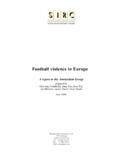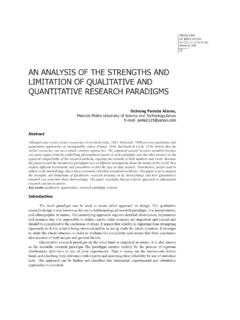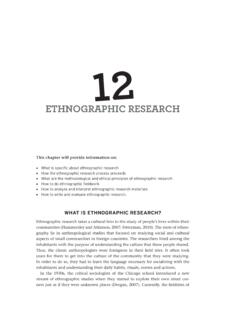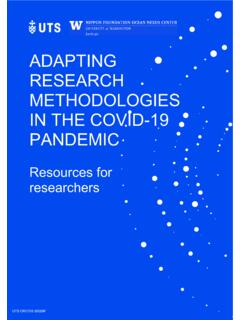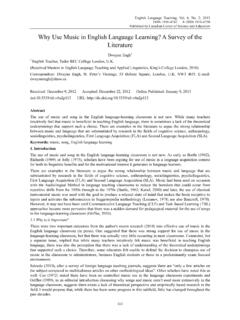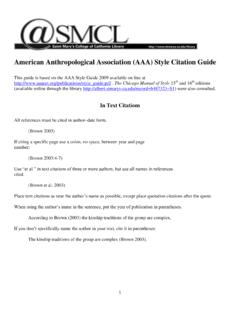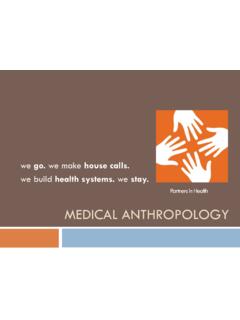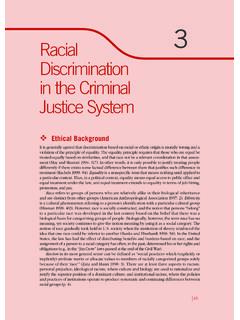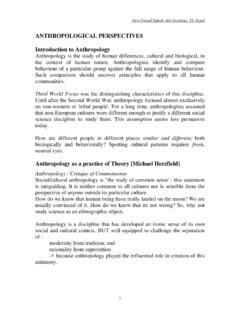Transcription of Food and Eating An Anthropological Perspective
1 Food and Eating : An AnthropologicalPerspectiveBy Robin FoxThe Myth of NutritionWe have to eat; we like to eat; Eating makes us feel good; it is more importantthan sex. To ensure genetic survival the sex urge need only be satisfied a fewtimes in a lifetime; the hunger urge must be satisfied every is also a profoundly social urge. Food is almost always shared; people eattogether; mealtimes are events when the whole family or settlement or villagecomes together. Food is also an occasion for sharing, for distributing andgiving, for the expression of altruism, whether from parents to children,children to in-laws, or anyone to visitors and strangers.
2 Food is the mostimportant thing a mother gives a child; it is the substance of her own body,and in most parts of the world mother s milk is still the only safe food forinfants. Thus food becomes not just a symbol of, but the reality of, love animals eat, but we are the only animal that cooks. So cooking becomesmore than a necessity, it is the symbol of our humanity, what marks us offfrom the rest of nature. And because Eating is almost always a group event (asopposed to sex), food becomes a focus of symbolic activity about sociality andour place in our body needs fuel.
3 But this need could be served by a rough diet of smallgame, roots, and berries, as it was for several million years. Or, even moreextreme, pills could be synthesized to give us all we need (except bulk). Butour tastes have never been governed solely by nutrition. Modernnutritionists chanted the litany of the four food types (vegetables, grains,dairy products, meats) from which we were supposed to take more or lessequal amounts daily. But dairy and domestic meat fats are now consideredharmful, and a new food pyramid equally misleading is being fact, nutrition plays only a small part in our food choices.
4 Adele Davis,whose bossy opinions on food were to a whole generation as authoritative asDr. Spock s on childrearing (she recommended a diet of liver and yogurt),held that European history was determined by food habits. The French atewhite bread and drank wine and strong coffee, she said, and this was about asnutritionally disastrous as possible; the Germans, on the other hand, ate darkbread and drank beer both nutritionally sound. Was it any wonder, sheasked, that the Germans kept beating the French? But even if both nationswere to accept this interesting hypothesis as sound, do we believe they wouldchange their food preferences?
5 |Social Issues research Centre1 Nor are these preferences solely governed by what is available. All cultures goto considerable lengths to obtain preferred foods, and often ignore valuablefood sources close at hand. The English do not eat horse and dog;Mohammedans refuse pork; Jews have a whole litany of forbidden foods (seeLeviticus); Americans despise offal; Hindus taboo beef and so on. Peoplewill not just eat anything, whatever the circumstances. In fact, omnivorousnessis often treated as a joke. The Chinese are indeed thought by their morefastidious neighbors to eat anything.
6 The Vietnamese used to say that the bestway to get rid of the Americans would be to invite in the Chinese, who wouldsurely find them good to Eat What You AreSince everyone must eat, what we eat becomes a most powerful symbol ofwho we are. To set yourself apart from others by what you will and will noteat is a social barrier almost as powerful as the incest taboo, which tells uswith whom we may or may not have sex. Some cultures equate the twotaboos. Margaret Mead quotes a New Guinea proverb that goes, Your ownmother, your own sister, your own pigs, your own yams which you have piledup, you may not eat.
7 Own food, like related women, is for exchange, for giftgiving, for social generosity, for forging alliances, but not for personalconsumption. The obverse of this is that you identify yourself with others byeating the same things in the same way. To achieve such identification, peoplewill struggle to eat things they loath, and avoid perfectly tasty food that is onthe forbidden list. In the process of social climbing people have to learn to likecaviar, artichokes, snails, and asparagus, and scorn dumplings, fish and chips,and meat and potato pie all more nutritious, but fatally tainted withlower-class are as many kinds of food identification as there are the same in fashion,speech, music, manners and the like.
8 The obvious ones are ethnic, religiousand class identifications. Ethnic food preferences only become identitymarkers in the presence of gustatory foreigners, such as when one goesabroad, or when the foreigners visit the home shores. The insecure will clingdesperately to home food habits: English housewives on the continent evenbreak open tea bags to make a proper cup of tea (the taste is identical).Popular songs attest to the food difficulties of interethnic marriages bangersand mash vs. macaroni. When various ethnic groups are forcibly throwntogether, there is both an intensifying of food identity and a growingmishmash.
9 The American melting pot is almost literally that: the foodpreferences of dozens of nations are put side by side, and there cannot help butbe overlap and mixing. The most startling example is the popularity of theChinese kosher restaurant, and it is not uncommon to find a restaurantadvertising itself as Chinese-Italian-American along with the proud boast All Our Wines Are Chilled. The ubiquitous diner with its vast menuserved twenty-four hours a day is a microcosm of the melting pot, havingGreek salad, Italian pasta, German rye bread, Polish kielbasi, Chinese chowmein, Belgian waffles, French quiche, Hungarian goulash, Irish stew, Jewishgefilte fish, Russian blintzes, English muffins, Austrian pastries, Swiss cheese,Social Issues research Centre2 Food and Eating .
10 An Anthropological PerspectiveYou Eat What You AreMexican enchiladas, Spanish gazpacho, Canadian bacon, Japanese teriyaki,German sausages, Norwegian herring, Lebanese pita, Nova Scotia salmon andVirginia and Table MannersNot knowing how to eat properly is universally a sign of outsider Eating includes the kind of food used, the way of preparing it, themanner of serving it, and the way of Eating it. The intricacies of the teaceremony are known only to experienced Japanese; social climbers in theWest can be spotted immediately by their inability to master the details ofplace settings; using the wrong fork is an offense as grave as spitting inpublic.




